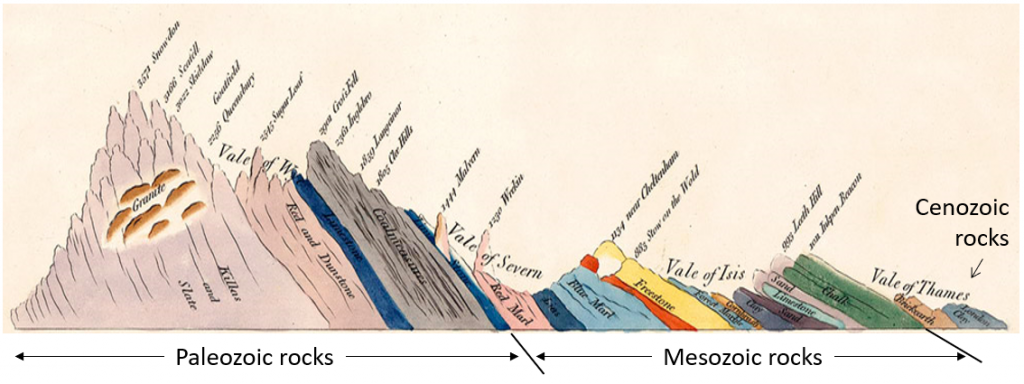65 8.1 The Geological Time Scale — Physical Geology – 2nd Edition

Smith’s work set the stage for the naming and ordering of the geological periods, which was initiated around 1820, first by British geologists, and later by other European geologists. Many of the periods are named for places where rocks of that age are found in Europe, such as Cambrian for Cambria (Wales), Devonian for Devon in England, Jurassic for the Jura Mountains in France and Switzerland, and Permian for the Perm region of Russia. Some are named for the type of rock that is common during that age, such as Carboniferous for the coal- and carbonate-bearing rocks of England, and Cretaceous for the chalks of England and France.
The early time scales were only relative because 19th century geologists did not know the ages of the rocks. That information was not available until the development of isotopic dating techniques early in the 20th century.
The geological time scale is currently maintained by the International Commission on Stratigraphy (ICS), which is part of the International Union of Geological Sciences. The time scale is continuously being updated as we learn more about the timing and nature of past geological events. You can view the ICS time scale online. It would be a good idea to print a copy (in colour) to put on your wall while you are studying geology.
Geological time has been divided into four eons: Hadean (4570 to 4850 Ma), Archean (3850 to 2500 Ma), Proterozoic (2500 to 540 Ma), and Phanerozoic (540 Ma to present). As shown in Figure 8.1.2, the first three of these represent almost 90% of Earth’s history. The last one, the Phanerozoic (meaning “visible life”), is the time that we are most familiar with because Phanerozoic rocks are the most common on Earth, and they contain evidence of the life forms that we are familiar with to varying degrees.

The Phanerozoic eon—the past 540 Ma of Earth’s history—is divided into three eras: the Paleozoic (“early life”), the Mesozoic (“middle life”), and the Cenozoic (“new life”), and each of these is divided into a number of periods (Figure 8.1.3). Most of the organisms that we share Earth with evolved at various times during the Phanerozoic.

The Cenozoic era, which represents the past 65.5 Ma, is divided into three periods: Paleogene, Neogene, and Quaternary, and seven epochs (Figure 8.1.4). Dinosaurs became extinct at the start of the Cenozoic, after which birds and mammals radiated to fill the available habitats. Earth was very warm during the early Eocene and has steadily cooled ever since. Glaciers first appeared on Antarctica in the Oligocene and then on Greenland in the Miocene, and covered much of North America and Europe by the Pleistocene. The most recent of the Pleistocene glaciations ended around 11,700 years ago. The current epoch is known as the Holocene. Epochs are further divided into ages (a.k.a. stages), but we won’t be going into that level of detail here.

Most of the boundaries between the periods and epochs of the geological time scale have been fixed on the basis of significant changes in the fossil record. For example, as already noted, the boundary between the Cretaceous and the Paleogene coincides exactly with a devastating mass extinction. That’s not a coincidence. The dinosaurs and many other types of organisms went extinct at this time, and the boundary between the two periods marks the division between sedimentary rocks with Cretaceous organisms (including dinosaurs) below, and Paleogene organisms above.
Image Descriptions
| Era | Period | Time span |
|---|---|---|
| Paleozoic | Cambrian | 488 to 540 Ma |
| Paleozoic | Ordovician | 488 to 444 Ma |
| Paleozoic | Silurian | 444 to 416 Ma |
| Paleozoic | Devonian | 416 to 359 Ma |
| Paleozoic | Carboniferous | 359 to 299 Ma |
| Paleozoic | Permian | 299 to 251 Ma |
| Mesozoic | Triassic | 251 to 202 Ma |
| Mesozoic | Jurassic | 202 to 146 Ma |
| Mesozoic | Cretaceous | 146 to 65.5 Ma |
| Cenozoic | Paleogene | 65.5 to 23 Ma |
| Cenozoic | Neogene | 23 to 2.6 Ma |
| Cenozoic | Quaternary | 2.6 Ma to present |
| Period | Epoch | Time span |
|---|---|---|
| Paleogene | Paleocene | 65.5 to 55.8 Ma |
| Paleogene | Eocene | 55.8 to 33.9 Ma |
| Paleogene | Oligocene | 33.9 to 23.0 Ma |
| Neogene | Miocene | 23.0 to 5.3 Ma |
| Neogene | Pliocene | 5.3 to 2.6 Ma |
| Quaternary | Pleistocene | 2.6 Ma to 11,700 years ago |
| Quaternary | Holocene | 11,700 years ago to the present |
Media Attributions
- Figure 8.1.1: “Sketch of the succession of strata and their relative altitudes” by William Smith. Adapted by Steven Earle. Public domain.
- Figures 8.1.2, 8.1.3, 8.1.4: © Steven Earle. CC BY.
<!– pb_fixme –>
<!– pb_fixme –>

